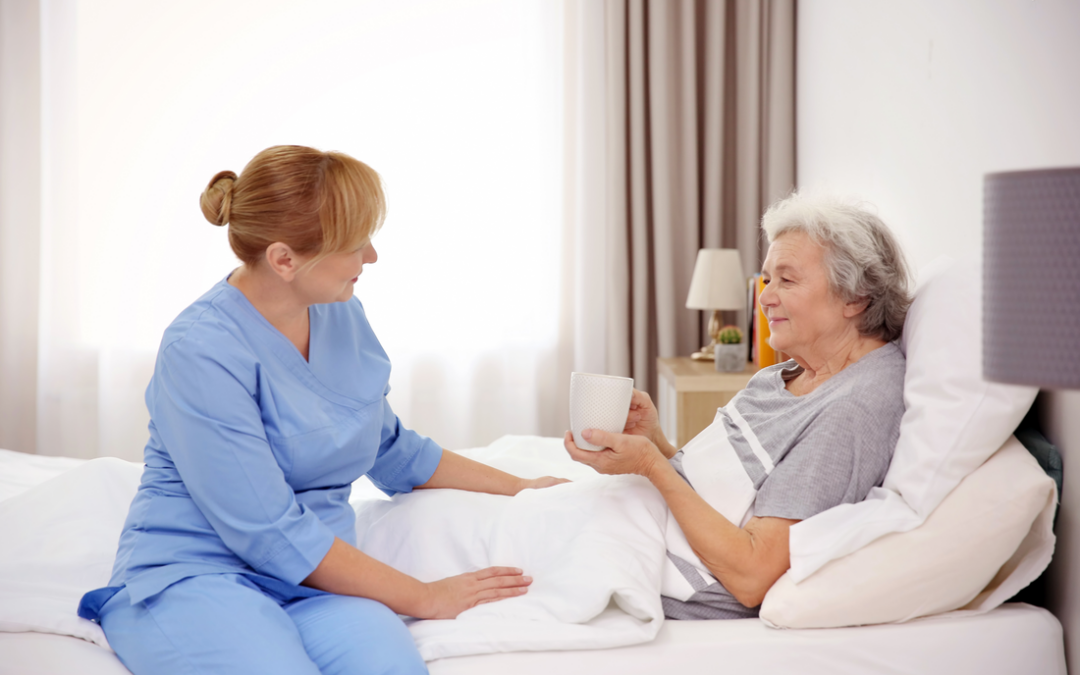Also known as sundown syndrome, ‘sundowning’ is a phenomenon where older adults can experience increased disorientation, confusion, agitation, and restlessness in the late afternoon or evening. While the exact causes of sundowning are not fully known, understanding the potential contributing factors is an essential first step for family or private-duty caregivers in helping to reduce the risk and minimize its effects.
Coping with elderly patients experiencing sundowning can be emotionally challenging for caregivers due to the unpredictable and often distressing behaviors exhibited. Caregivers may find it difficult to witness their loved ones or patients in a state of distress and may struggle to manage these behaviors effectively.
Caregivers must seek support, education, and resources to better understand and cope with the challenges of sundowning in elderly patients. This support can come from various sources, including the healthcare team. With the guidance and support of healthcare professionals, caregivers can take some proactive steps to help manage and reduce the effects of sundowning.
Common Influencing Factors
The phenomenon of sundowning is not a disease but a group of symptoms that occur late in the afternoon and early evening. Causes associated with the onset of sundowning in seniors include disruptions in the sleep-wake cycle, hormonal imbalances, environmental changes, and triggers such as low lighting or increased noise levels. Transitions such as hospitalizations or moves to other facilities are also common triggers. Neurological changes in the brain that occur with Alzheimer’s disease and other forms of dementia can also lead to sundowning.
Coping with and managing the symptoms of sundowning can be challenging and emotionally stressful for caregivers. However, caregivers can take some proactive steps to help manage and reduce the effects of sundowning. These include incorporating measures such as creating a calming and consistent environment for seniors experiencing sundowning and additional proactive means of helping to redirect and minimize the risk of escalating symptoms.
Typical Associated Behaviors
Sundowning can cause various behaviors, such as confusion, anxiety, aggression, or ignoring directions, and can also lead to pacing or wandering. A 2023 study in the Journal of Alzheimer’s Disease found that of those who experienced sundowning, about half exhibited symptoms of agitation, irritability, and anxiety. Other symptoms that can exist at varying degrees may include:
• Mood swings
• Sadness
• Surges in energy
• Hallucinations
• Delusions
Symptoms such as these can lead to challenging behaviors such as pacing, rocking, screaming, crying, disorientation, resistance, anger, aggression — even violence, according to 11 Ways to Manage Sundown Syndrome by AARP. The article points out that some patients may experience the need to flee from their surroundings. For some, the behavior may lessen more quickly; for others, it can continue and ebb and flow in intensity for hours.
Be Aware of Common Contributing Factors
The exact cause of sundowning is not known. Contributing factors include disruptions of the body’s “internal clock,” which regulates sleep-wake cycles, fatigue, spending a day in an unfamiliar place, low lighting, increased shadows, hunger or thirst, the presence of an infection such as a UTI, boredom or pain, and depression. Being overly tired can also increase late afternoon and early evening restlessness.
Seniors experiencing sundowning may have difficulty communicating, exhibit mood swings, and struggle with memory and cognition, making interactions with caregivers more challenging. It is essential for caregivers to provide support, reassurance, and a calming environment to help seniors cope with these difficult feelings associated with sundowning.
Tips for Reducing Sundowning
Situating an elderly patient near a window can help alleviate sundowning by providing exposure to natural light and external stimuli. Natural light exposure helps regulate the body’s internal clock and can improve the patient’s circadian rhythm, which may reduce symptoms of sundowning. Additionally, being near a window allows the patient to see changes in the environment, such as the transition from day to night, which can help orient them to the time of day and reduce confusion. The view of outdoor scenery and activities can also provide a calming and engaging distraction for the patient, potentially reducing feelings of restlessness and agitation commonly associated with sundowning. Overall, positioning elderly patients near a window can help them remain more oriented, thereby helping to reduce or minimize the onset of anxiety and confusion. It also creates a more soothing and stimulating environment that may help manage sundowning symptoms effectively.
Engaging and redirecting elderly patients with pleasant conversation can help alleviate sundowning by providing mental stimulation, social interaction, and emotional support. Pleasant conversations can help distract the patient from distressing thoughts or behaviors associated with sundowning, redirecting their focus to more positive and engaging topics.
Social interaction and engagement during the later afternoon and early evening through pleasant conversation can also help to redirect patients from feelings and thought patterns leading to anxiety, disorientation, and fear. Proactively engaging patients in pleasant conversation and social interactions during this period of the day can also help reduce feelings of loneliness and isolation, common triggers for sundowning behaviors.
Engaging in meaningful conversations can also stimulate cognitive function and memory, promoting mental acuity and overall well-being in elderly patients. Caregivers can help alleviate sundowning symptoms and improve the patient’s emotional state by fostering a supportive and engaging environment through pleasant conversation.
When managing the symptoms of sundowning, caregivers should speak to elderly patients calmly and compassionately. Providing comfort, reassurance, validation, and emotional support to the patient during times of confusion or distress can help alleviate sundowning symptoms and improve their overall well-being.
Additional Practices to Reduce Late-Day Confusion
Some additional practical tips for helping to minimize the risk of sundowning and manage its symptoms include:
• Keep a predictable routine for bedtime, waking, meals, and activities
• Plan for activities and exposure to light during the day to support nighttime sleepiness
• Incorporate times of meaningful conversation and engagement throughout the day
• Discourage long naps and dozing late in the day
• Limit caffeine and sugar to morning hours
• Incorporate movement and physical activity into daily routines
• Turn on a night light to reduce agitation that occurs when surroundings are dark or not familiar
• In the evening, reduce background noise and stimulating activities, including TV
• In a strange or unfamiliar setting, bring familiar items, such as photographs.
• Whenever possible, accompany elderly patients during the transition to new environments. For example, if a home care patient is transitioned to a hospitalization, visit with the patient whenever possible to help them acclimate and orient to the situation and facility. Engage in soothing conversation and interaction, particularly during the later day.
• Discussing familiar and pleasant topics with the patient can help redirect anxiety-producing thoughts and emotionally soothe patients. Perhaps look at family photos or discuss enjoyable activities.
• In the evening, play familiar, gentle music or relaxing sounds of nature.
• Avoid alcoholic drinks and beverages with caffeine, such as coffee or cola, late in the day.
Seek Help and Support
The increased demands and stress of caring for someone experiencing sundowning can lead to frustration, helplessness, and burnout for caregivers. It is important for caregivers to seek support, education, and resources to better understand and cope with the challenges of sundowning in elderly patients.
Family and professional caregivers should work closely with healthcare providers, including doctors, nurses, and therapists, to develop a personalized care plan that addresses the specific needs and challenges of elderly and memory care patients experiencing sundowning.
PCMatch specializes in providing expert, holistic in-home caregiving services for seniors and patients who have Alzheimer’s disease and other forms of dementia tailored to the specific needs of each individual. Our full-service home care agency ensures authentic companionship as part of our integrated, personalized, holistic care plans. Our care staff is specially trained to foster meaningful client relationships and companionship that promotes wellness and cognitive engagement; this personalized approach ensures comfort and well-being but also fosters a sense of familiarity and security for the patient and can help to reduce the risk and symptoms of sundowning.
Whether your loved one requires round-the-clock care and supervision or just a few weekly visits, we are here to help! Contact us today to learn more about our flexible care models.
References:
https://www.nia.nih.gov/health/alzheimers-changes-behavior-and-communication/coping-agitation-aggression-and-sundowning
Understanding Dementia & Sundown Syndrome Connection. https://vantagepointevillage.com/blog/dementia-and-sundown-syndrome-exploring-the-connection/
11 Ways Dementia Caregivers Can Sooth Sundowners Syndrome. https://www.aarp.org/caregiving/health/info-2017/ways-to-manage-sundown-syndrome.html?intcmp=AE-CAR-BAS-EOA3
What is Sundowning or late-day confusion?. https://familycaregiversonline.net/what-is-sundowning-or-late-day-confusion/page/3/?et_blog

